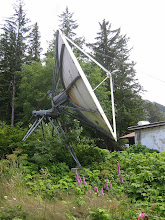The ARCS system is monitored, maintained, managed and operated by Alaska Public Broadcasting, Inc., from it's headquarters in Anchorage where a FEMA observer joined the ARCS team as they monitored their part in the exercise. This first video was recorded on a Canon PowerShot A540 camera stationed in front of the main ARCS multi-monitor display. In the video you can see the ARCS channel at the top left, as well as bottom center, using two separate and different models of satellite receivers for confidence. In the video you can hear the exercise being carried out via the conference call on speaker phone in the background, as well as the audio over ARCS in the foreground.
At the time of the test, ARCS was carrying the local CBS affiliate, KTVA. just before the initial header burst is heard, you can see a slide proclaiming "this is a test" put up by KTVA. A few seconds later, the "Chill, It's Just A Drill" slide provided by the Alaska Broadcasters Association and designated by the State of Alaska's Emergency Preparedness Office, was invoked by remote control of the ARCS video switcher. You can see this slide was also used by the statewide Public Television channel, Alaska One, in the upper right hand corner of the display. In the lower right hand corner is a feed from GCI Cable TV, and at lower left the University of Alaska Television channel (UATV). The time displayed at center screen is accurate to within one second.
At the time of the test, ARCS was carrying the local CBS affiliate, KTVA. just before the initial header burst is heard, you can see a slide proclaiming "this is a test" put up by KTVA. A few seconds later, the "Chill, It's Just A Drill" slide provided by the Alaska Broadcasters Association and designated by the State of Alaska's Emergency Preparedness Office, was invoked by remote control of the ARCS video switcher. You can see this slide was also used by the statewide Public Television channel, Alaska One, in the upper right hand corner of the display. In the lower right hand corner is a feed from GCI Cable TV, and at lower left the University of Alaska Television channel (UATV). The time displayed at center screen is accurate to within one second.
At the end of the test, you can hear the End Of Message (EOM) bursts indicating the end of the exercise on ARCS. As our system returned to regular programming you can see that the switcher was instructed manually (in error) to go to Alaska One for a couple of seconds before being further switched (correctly) back to KTVA. Even though the exercise had run its course and was completed at this time, you can see and hear some of the video and audio still present on KTVA.
You may be able to see in the crawl at upper right that the time listed for the event is 11:02 to 11:17. This should have read 10:02 to 10:17 and was the result of a an incorrect UTC offset inside the Sage ENDEC at the ARCS uplink suite. That error has now been corrected.
Below are images of the two printouts from the ARCS ENDEC boxes. First is the tape from the unit at the ARCS switcher showing that it did indeed receive the message from KFQD and successfully relayed the message. You can also see that the time error is evident on this tape. Second is the tape from the monitoring station at APBI's office in Anchorage. Notice that the time on this tape is correct, demonstrating that the UTC offset was correctly set on this unit.
This second video was recorded on a separate receiver tuned only to ARCS and fed into a VHS recorder. It was later converted into digital format for presentation here. This is what the ARCS viewers in communities around rural Alaska would have seen.
In summary, the ARCS and APBI staff are happy to have been able to participate successfully in this exercise and would like to thank all those involved.
In summary, the ARCS and APBI staff are happy to have been able to participate successfully in this exercise and would like to thank all those involved.






